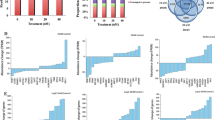Abstract
Acrolein is a highly reactive α, β-unsaturated aldehyde that is an environmental pollutant, a product of endogenous lipid peroxidation and a major component of cigarette smoke, which has been linked to the development of atherosclerotic vascular disease. Activation of endothelial cells by stimuli such as cigarette smoke is an important risk factor in atherosclerosis. Several studies have reported that acrolein levels are increased in atherosclerosis. Presently, a whole human DNA chip containing 24,000 genes was utilized to examine atherogenesis-related gene expression profiles of acrolein-stimulated human umbilical vein endothelial cells (HUVECs). Genes whose expression changed more than 2-fold included 3,174 up-regulated genes and 551 down-regulated genes. The affected genes included human atherogenesis-related genes such as cytokines, chemokines and adhesion molecules. These results support the view that acrolein-stimulated changes in HUVEC gene expression contribute to the development of atherosclerosis.
Similar content being viewed by others
References
Berliner, J.A. & Heinecke, J.W. The role of oxidized lipoproteins in atherogenesis. Free Radic. Biol. Med. 20, 707–727 (1996).
Stocker, R. & Keaney, J.F., Jr. Role of oxidative modifications in atherosclerosis. Physiol. Rev. 84, 1381–1478 (2004).
Victor, V.M. et al. Oxidative stress, endothelial dysfunction and atherosclerosis. Curr. Pharm. Des. 15, 2988–3002 (2009).
He, J. et al. Risk factors for congestive heart failure in US men and women: NHANES I epidemiologic follow-up study. Arch. Intern. Med. 161, 996–1002 (2001).
Ockene, I.S. & Miller, N.H. Cigarette smoking, cardiovascular disease, and stroke: a statement for healthcare professionals from the American Heart Association. American Heart Association Task Force on Risk Reduction. Circulation 96, 3243–3247 (1997).
Black, H. Smoking and cardiovascular disease. Hypertension: Pathophysiology, Diagnosis and Management 2v, 2621–2647 (1995).
Lee, S.H. et al. Identification of atherosclerosis related gene expression profiles by treatment of Benzo(a)-pyrene in human umbilical vein endothelial cells. Mol. Cell. Toxicol. 5, 113–119 (2009).
Barnoya, J. & Glantz, S.A. Cardiovascular effects of secondhand smoke: nearly as large as smoking. Circulation 111, 2684–2698 (2005).
Carmella, S.G. et al. Quantitation of acrolein-derived (3-hydroxypropyl) mercapturic acid in human urine by liquid chromatography-atmospheric pressure chemical ionization tandem mass spectrometry: effects of cigarette smoking. Chem. Res. Toxicol. 20, 986–990 (2007).
Talhout, R., Opperhuizen, A. & van Amsterdam, J.G. Sugars as tobacco ingredient: Effects on mainstream smoke composition. Food. Chem. Toxicol. 44, 1789–1798 (2006).
Marnett, L.J., Riggins, J.N. & West, J.D. Endogenous generation of reactive oxidants and electrophiles and their reactions with DNA and protein. J. Clin. Invest. 111, 583–593 (2003).
LoPachin, R.M. & Barber, D.S. Synaptic cysteine sulfhydryl groups as targets of electrophilic neurotoxicants. Toxicol. Sci. 94, 240–255 (2006).
Calingasan, N.Y., Uchida, K. & Gibson, G.E. Proteinbound acrolein: a novel marker of oxidative stress in Alzheimer’s disease. J. Neurochem. 72, 751–756 (1999).
Shao, B. et al. Acrolein impairs ATP binding cassette transporter A1-dependent cholesterol export from cells through site-specific modification of apolipoprotein A-I. J. Biol. Chem. 280, 36386–36396 (2005).
Hamann, K. et al. Critical role of acrolein in secondary injury following ex vivo spinal cord trauma. J. Neurochem. 107, 712–721 (2008).
Hamann, K., Nehrt, G., Ouyang, H., Duerstock, B. & Shi, R. Hydralazine inhibits compression and acroleinmediated injuries in ex vivo spinal cord. J. Neurochem. 104, 708–718 (2008).
Luo, J. & Shi, R. Acrolein induces axolemmal disruption, oxidative stress, and mitochondrial impairment in spinal cord tissue. Neurochem. Int. 44, 475–486 (2004).
Conklin, D.J. et al. Acrolein generation stimulates hypercontraction in isolated human blood vessels. Toxicol. Appl. Pharmacol. 217, 277–288 (2006).
McCall, M.R., Tang, J.Y., Bielicki, J.K. & Forte, T.M. Inhibition of lecithin-cholesterol acyltransferase and modification of HDL apolipoproteins by aldehydes. Arterioscler. Thromb. Vasc. Biol. 15, 1599–1606 (1995).
Alfredsson, L., Hammar, N. & Hogstedt, C. Incidence of myocardial infarction and mortality from specific causes among bus drivers in Sweden. Int. J. Epidemiol. 22, 57–61 (1993).
Hoffmann, D., Melikian, A.A. & Brunnemann, K.D. Studies in tobacco carcinogenesis. IARC Sci. Publ. 482–484 (1991).
Ranganna, K. et al. Acrolein activates mitogen-activated protein kinase signal transduction pathways in rat vascular smooth muscle cells. Mol. Cell. Biochem. 240, 83–98 (2002).
Lee, N.J., Lee, S.E., Lee, S.H., Ryu, D.S. & Park, Y.S. Acrolein induces adaptive response through upregulate of HO-1 via activation of Nrf2 in RAW 264.7 macrophage. Mol. Cell. Toxicol. 5, 230–236 (2009).
Kachel, D.L. & Martin, W.J., 2nd. Cyclophosphamideinduced lung toxicity: mechanism of endothelial cell injury. J. Pharmacol. Exp. Ther. 268, 42–46 (1994).
Lovell, M.A., Xie, C. & Markesbery, W.R. Acrolein is increased in Alzheimer’s disease brain and is toxic to primary hippocampal cultures. Neurobiol. Aging. 22, 187–194 (2001).
Puranik, R. & Celermajer, D.S. Smoking and endothelial function. Prog. Cardiovasc. Dis. 45, 443–458 (2003).
Gross, C.M. et al. Angiotensin II type 1 receptor expression in human coronary arteries with variable degrees of atherosclerosis. Basic Res. Cardiol. 97, 327–333 (2002).
Zernecke, A., Shagdarsuren, E. & Weber, C. Chemokines in atherosclerosis: an update. Arterioscler. Thromb. Vasc. Biol. 28, 1897–1908 (2008).
Amoruso, A. et al. Enhanced peroxisome proliferators-activated receptor-gamma expression in monocyte/macrophages from coronary artery disease patients and possible gender differences. J. Pharmacol. Exp. Ther. 331, 531–538 (2009).
Rozenberg, O., Rosenblat, M., Coleman, R., Shih, D.M. & Aviram, M. Paraoxonase (PON1) deficiency is associated with increased macrophage oxidative stress: studies in PON1-knockout mice. Free Radic. Biol. Med. 34, 774–784 (2003).
Kawakami, A. et al. Toll-like receptor 2 mediates apolipoprotein CIII-induced monocyte activation. Circ. Res. 103, 1402–1409 (2008).
Kurisaki, A. et al. The mechanism of nuclear export of Smad3 involves exportin 4 and Ran. Mol. Cell. Biol. 26, 1318–1332 (2006).
Park, Y.S. et al. Acrolein induces cyclooxygenase-2 and prostaglandin production in human umbilical vein endothelial cells: roles of p38 MAP kinase. Arterioscler. Thromb. Vasc. Biol. 27, 1319–1325 (2007).
Lee, S.E. et al. Uncaria rhynchophylla induces heme oxygenase-1 as a cytoprotective effect in RAW 264.7 macrophages. Mol. Cell. Toxicol. 6, 33–40 (2010).
Author information
Authors and Affiliations
Corresponding author
Rights and permissions
About this article
Cite this article
Lee, S.E., Lee, S.H., Ryu, D.S. et al. Differentially-expressed genes related to atherosclerosis in acrolein-stimulated human umbilical vein endothelial cells. BioChip J 4, 264–271 (2010). https://doi.org/10.1007/s13206-010-4402-7
Received:
Accepted:
Published:
Issue Date:
DOI: https://doi.org/10.1007/s13206-010-4402-7




